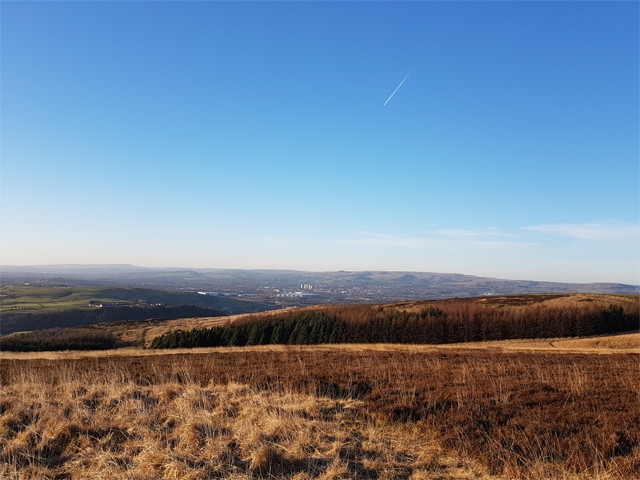‘Marvellous’ Moss planted on moorland to help combat flooding
Date published: 02 August 2018

Moorland near Oldham
Schoolkids in Oldham are helping to prevent flooding – by planning “super sponge” moss on moorland.
Spanning approximately 160 acres, and reaching an elevation of 391m, Crompton Moor is one of the largest open spaces in Oldham and a Site of Biological Importance.
The community of Crompton and Shaw in Oldham, which sits below the moorland, is at risk of flooding from the River Beal, and its tributaries.
With support from the Environment Agency’s Peatland Restoration Fund and partners Moors for The Future, Friends of Crompton Moor, and Oldham MBC, City of Trees helped to restore a section of the moor by planting sphagnum moss in a bid to use the vegetation to store water and to soak into the peat to reduce the impact of flooding.
Over 2,000 plants of mixed Sphagnum species were planted over an area of 2 hectares.
This moss essentially acts as a ‘super sponge’ holding up to 26 times its own weight in water, and it is hoped that in time the plants will reduce the volume and rate of rainfall runoff from the moor, which can contribute to flooding in the towns and villages below.
Members of the community got involved in the planting, as well as local children from Buckstones and St George’s Primary schools, helping to increase the understanding of the moor’s importance in safeguarding the local community as well as acting as a haven for wildlife.
They were also educated about the risk of fire on the moors and its devastating impact as illustrated by the recent Saddleworth Moor fires.
Bryan Cosgrove, City of Trees explains: “Since the industrial revolution the moor has been damaged by centuries of coal mining and heavy pollution.
“By planting this special spongey moss, and restoring the moor to its former glory, we hope it will increase the moor's capacity to store rainwater, and so reduce the number and severity of flood events downstream helping to protect people from flooding in the process.”
An Environment Agency spokesperson said: “Peatlands are one of our best natural resources and do a world of good in the fight against climate change by effectively storing carbon.
“It is therefore, vital that we do all that we can to enhance them.
“This regeneration project on Crompton Moor is a great example of how protecting peatlands and restoring natural Sphagnum species plant species will not only have huge environmental benefits but also provide a home for wildlife and greater protection against flood risk for the community.
“We are looking forward to continuing our work with City Of Trees and expanding peatland restoration across the whole of Greater Manchester.”
This innovative method was recently showcased on Springwatch where it is being used at Dovestones in Rochdale by the RSPB and United Utilities to help create a healthy peat bog to improve water quality, as well as re-introduce wildlife.
These peat bogs are internationally important as between 10-15 per cent of all the world’s blanket bogs are in the UK.
Not only do they provide a home for wildlife, improve water quality and combat flooding – but they also act as a crucial carbon sink, locking up carbon to prevent it getting into the atmosphere.
Sections of the moor will continue to be monitored in the long term by The Friends of Crompton Moor to see how the sphagnum is growing, and local schools will be encouraged to visit the site.
Most Viewed News Stories
- 1Milan Bar in Lees and The Bank at Delph close doors with immediate effect
- 2Latics announce retained list
- 3Punch perfect Kyle is Oldham's latest national boxing champ
- 4Attack on shop worker filmed and posted on Snapchat results in jail sentence for Oldham man
- 5Second-hand music, books and media shop opens in Mossley




